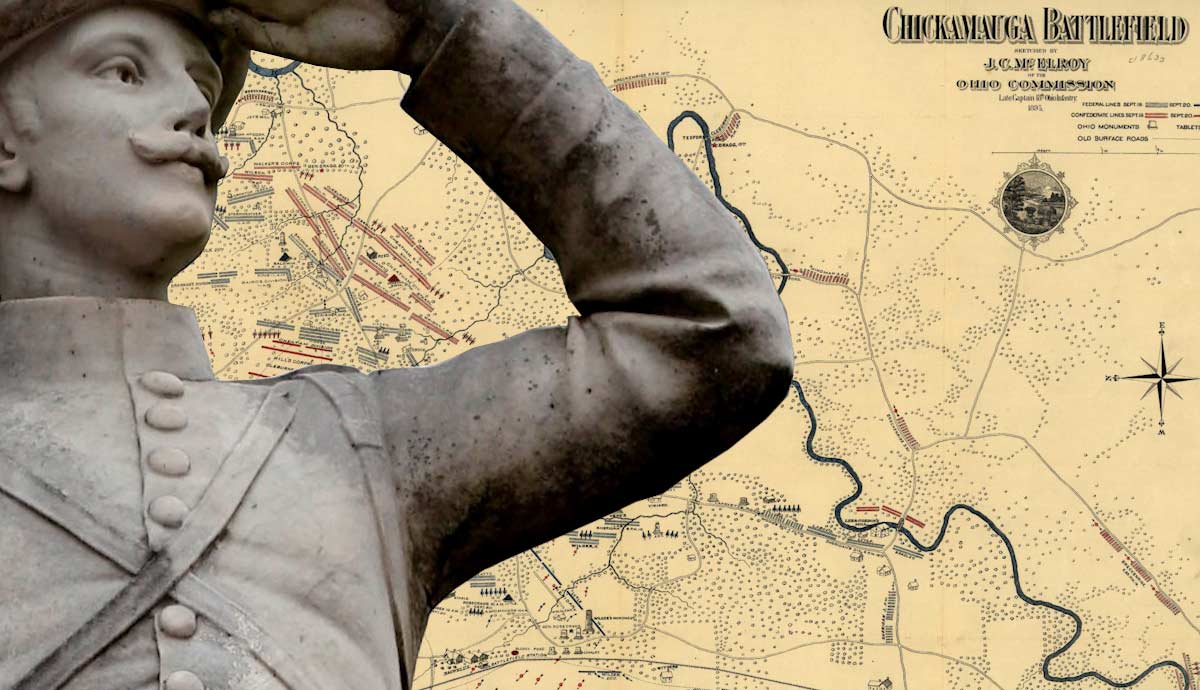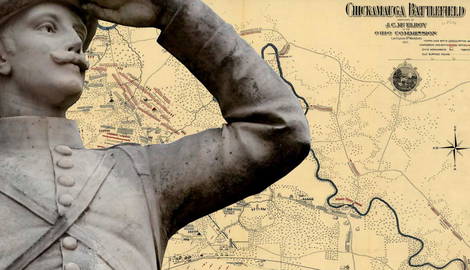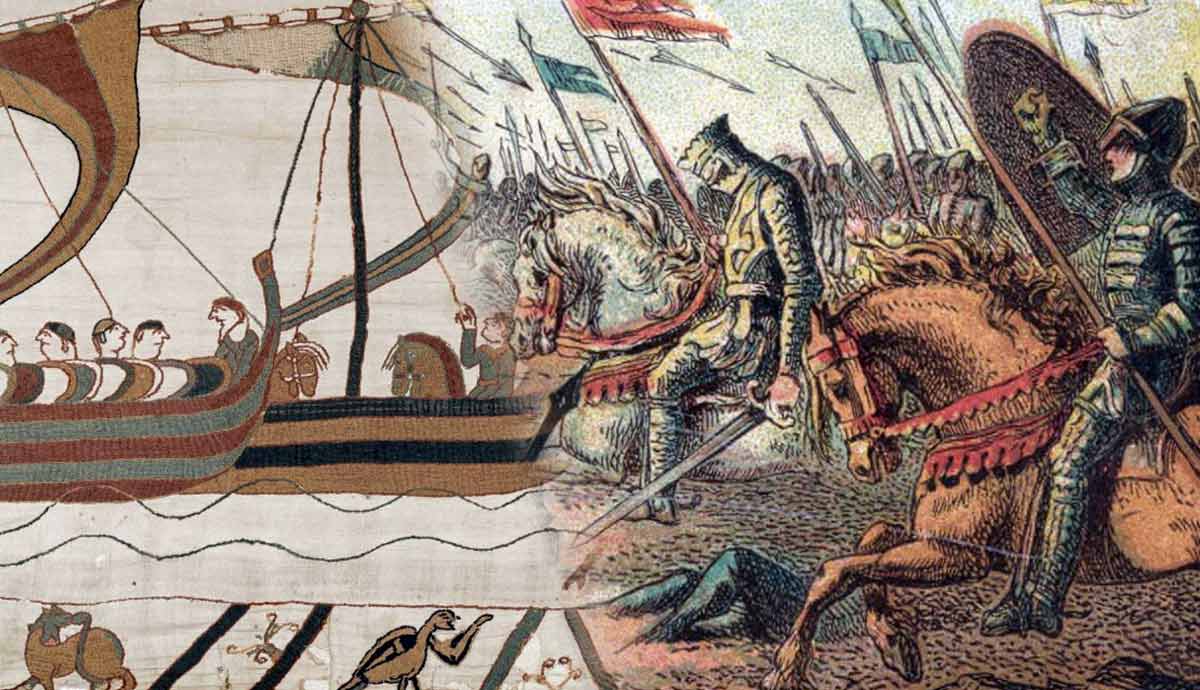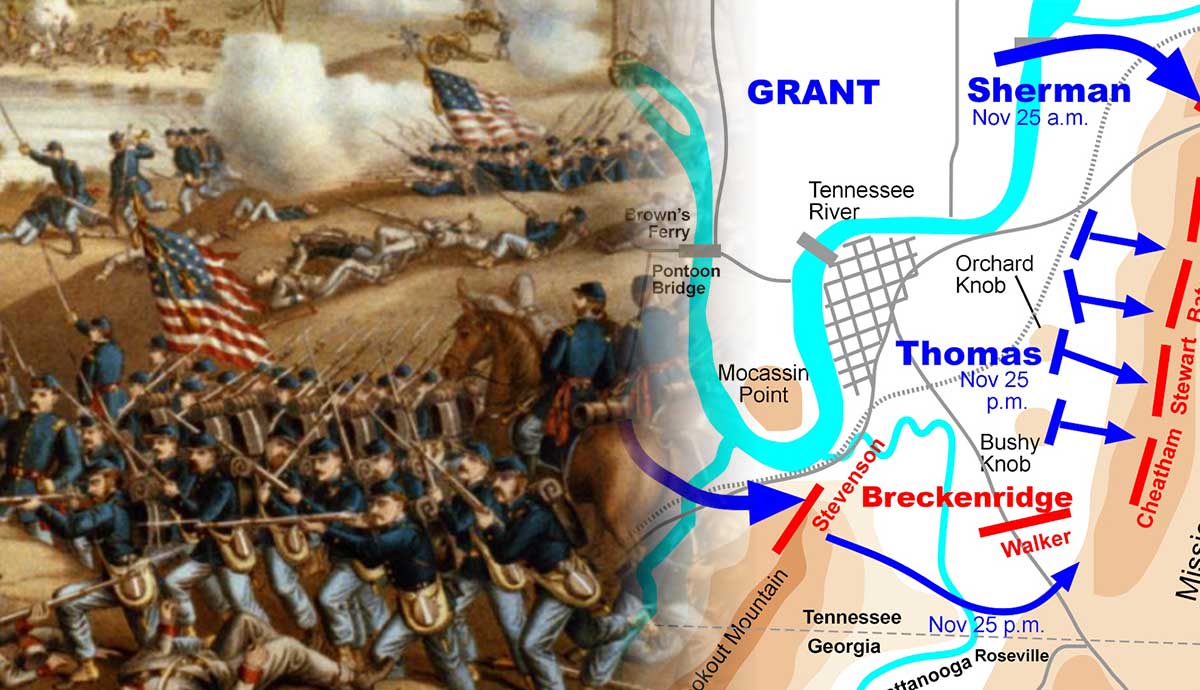
Though often overlooked by casual students of the Civil War, the Battle of Chickamauga is noteworthy for several reasons. Not only was it by far the largest battle in the Western Theater of the conflict, but it featured a rare role reversal where the Confederate victors lost the opportunity to pursue a defeated Union army. It also saw the first maneuvering of Confederate armies to achieve a local numerical superiority.
Victory Goes to the Confederacy

The Battle of Chickamauga was a rare reversal of typical Civil War roles between the Union and the Confederacy. Adopting tactics commonly used by the North, the South combined multiple armies to achieve a local numerical superiority. In a rarity, the Confederacy actually outnumbered the Union in the battle, though by a slim margin. In another rarity, the Confederacy effectively used its comparatively meager railway network to move troops to the theater of battle. Finally, the battle was the largest single engagement fought in the Western Theater rather than the narrow strip of land between Virginia and Washington DC (the Eastern Front).
In the battle, the forces of Confederate General Braxton Bragg defeated Union General William Rosecrans, leading to the Siege of Chattanooga. Although Chickamauga was a Confederate victory, Bragg’s forces failed to destroy the Union Army of the Cumberland, allowing it to escape intact. This led to continued fighting in Tennessee, which ultimately fell to the Union. Thus, Chickamauga largely only delayed the inevitable.
Timeline of the Battle of Chickamauga

After the Confederate defeat at Gettysburg, Bragg asked for reinforcements from the Eastern Theater. The first brigades of General James Longstreet arrived by September 9, 1863, and Confederate soldiers continued to arrive by rail until September 18. During this time, Confederate commanders under Bragg debated about when to attack the nearby forces of Union General Rosecrans. Rosecrans was under the impression that Braxton’s troops were in disarray and unlikely to mount an offensive. The Confederates’ delay actually allowed Rosecrans’ forces to gather and organize.
Skirmishing began on September 18, immediately after the arrival of Longstreet’s final brigades.

On the morning of the 19th, the entire armies were ready for battle. After an early morning skirmish between Union scouts and Confederate cavalry, all divisions quickly rushed into battle.
Lines remained largely unchanged on the 19th, but the 20th saw a Union miscommunication open up battle lines and allowed Confederates to surge through the opening. After fierce fighting, Union forces retreated, though saved from being routed (destroyed) by the swift leadership of General George Thomas, who earned the nickname “the Rock of Chickamauga.”
What Caused the Battle of Chickamauga?

The Battle of Chickamauga was caused by the Union’s focus on capturing Chattanooga, Tennessee to sever Confederate railroad use. With Chattanooga and the railroads captured, the Union could begin invading the Deep South and cut off a large portion of the Confederacy’s agricultural supplies. With the Army of Northern Virginia standing firm in the defense of the Confederate capital of Richmond, Virginia, the Union was trying to penetrate deep into the South from the Western Theater to eventually surround Richmond.
On September 9, Braxton Bragg abandoned Chattanooga and retreated to the south. However, when he heard William Rosecrans’ Army of the Cumberland was in disarray, he decided to return and attack. As Confederate reinforcements arrived from the Eastern Theater, the morale of Bragg’s men improved, and the general saw a chance to seize the initiative and destroy Rosecrans’ forces. After the Confederate loss at the enormous Battle of Gettysburg two months prior, the South was in desperate need of a victory to boost morale.
Why Was the Battle of Chickamauga Significant?

The Battle of Chickamauga was significant for several reasons. First, it was the largest battle in the Western Theater, which receives relatively little notice today. Secondly, it was a rare example of the Confederacy achieving numerical superiority. Third, it was a rare, and perhaps final, successful Confederate use of railways to move large numbers of troops. Throughout the war, the Union enjoyed the benefit of strong railway lines to move troops quickly. This allowed the North to bring troops to battle who were less tired and better equipped than their Southern opponents, who had to travel more by foot.
Although a victory for the Confederacy, Chickamauga was significant in that it revealed that even a victory in a major battle was no longer enough to turn the tide, even temporarily, in favor of the South. Union forces also claimed Chattanooga after the battle, with Braxton’s forces having to surround and besiege the city. Thus, the battle was a Pyrrhic victory that used up an unacceptable amount of Confederate manpower when little could be spared.
5 Facts About the Battle of Chickamauga

1. Casualties
Casualties at Chickamauga were the second-highest of the Civil War, second only to Gettysburg. In a rarity, the Confederates, having brought more men to battle, suffered more casualties than the Union. Over 2,300 Confederate soldiers were confirmed killed, versus less than 1,700 confirmed for the Union. Altogether, both armies suffered over 34,000 casualties, the majority of them wounded.
2. Commanders
Union forces were led by William Rosecrans, an 1842 graduate of West Point who returned there to teach shortly afterward. He resigned from the Army in 1854, worked in mining and oil, and volunteered for Union military service after the Battle of Fort Sumter. Rosecrans was given a commission and sent to the Western Theater, where he often feuded with fellow Union General Ulysses S. Grant. After his defeat at Chickamauga, Rosecrans was replaced by Grant.
Confederate forces were led by Braxton Bragg, who had graduated from West Point five years prior to Rosecrans. After fighting in the Seminole War in Florida, he served in the Mexican-American War with great distinction. Following the Mexican-American War, Bragg left the Army and was a major slaveowner in Louisiana. Despite his victory at Chickamauga, Bragg’s controversial personality and otherwise mediocre performance as a general led to him being removed from active service in December 1863. He served as a military advisor to Confederate President Jefferson Davis until the end of the Civil War.
3. Number of Forces Involved
Up to 125,000 soldiers fought at Chickamauga, with 60,000 under Union General Rosecrans and 65,000 under Confederate General Bragg. This makes Chickamauga one of the largest battles of the Civil War. Such large battles were rarer in the Western Theater, with most major clashes occurring in the East between the Union Army of the Potomac and the Confederate Army of Northern Virginia.
4. Visiting Chickamauga & Chattanooga National Military Park
Today, the battlefield can be visited as part of a 10,000-acre national military park operated by the National Park Service. There are multiple visitor centers, as well as guided tours, both on foot and by vehicle. Visitors can also explore the battlefield on their own, with 50 miles of hiking trails available. Horseback riding and boating opportunities are also available in some areas of the national military park, although boats must be launched from outside the park and paddled in. The battlefield visitor center is only about 10 miles from Chattanooga, so there are plenty of options for places to stay.
5. Trivia: Last Major Confederate Victory in the West
Although Chickamauga was a Confederate victory, it did nothing to turn the tide of war. By failing to pursue the beaten Union army and allow it to return to Chattanooga, the Confederates did not regain control of the railway lines. Bragg besieged the Union-captured city, but this siege was broken a few months later under the leadership of Ulysses S. Grant. This led Grant to be named General-in-Chief of all Union armies. Therefore, the Confederacy’s last major victory in the Western Theater over General William Rosecrans set the stage for Rosecrans’ successor, Ulysses S. Grant, to become General-in-Chief and, after winning the presidential election in 1868, commander-in-chief.
Aftermath of Chickamauga: Loss of the Élan of the Southern Soldier

The victory at Chickamauga only shortly delayed the inevitable Union seizure of the Deep South. By the end of November, nine weeks after the Battle of Chickamauga, the Union broke the Confederates’ siege of Chattanooga. Some saw Bragg’s failure to pursue and destroy Rosecrans’ Army of the Cumberland as the “death knell of the Southern Rebellion.” With much less manpower and equipment, the Confederacy could not afford to make any strategic errors. The survival of Rosecrans’ army, Chattanooga remaining in Union hands, and the high casualties of the battle led to Confederate general D.H. Hill’s claim that the “élan of the Southern soldier was never seen after Chickamauga.”
Thus, the “victory” at Chickamauga and its lack of tangible gain could be seen as the moment most Confederates realized the war was unwinnable. Militarily, the South could not prevail. The only possible hope would be political maneuvering within the Union itself, likely during the 1864 elections. But the South, having lost at Antietam and Gettysburg, could no longer turn the tide of war. Even a victory on its home turf was not enough to stop the North’s advance. The remainder of the Civil War would be defensive posturing from the Confederacy.










